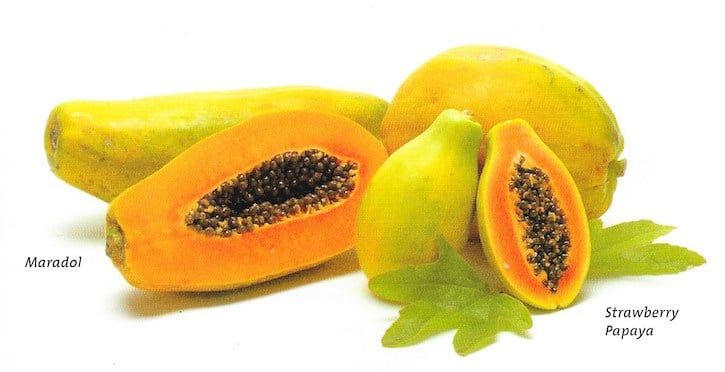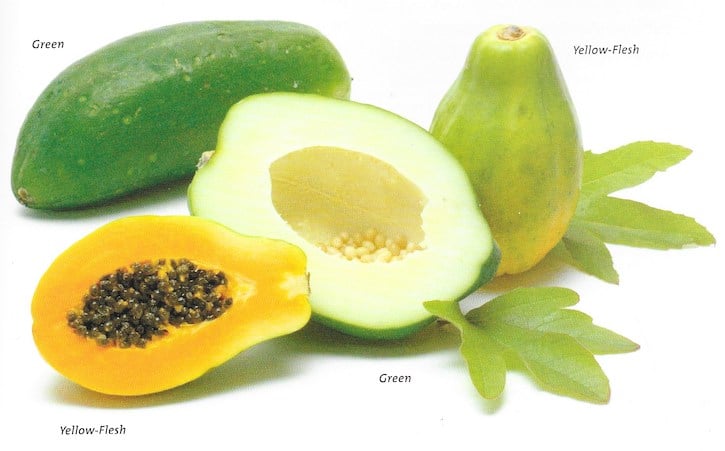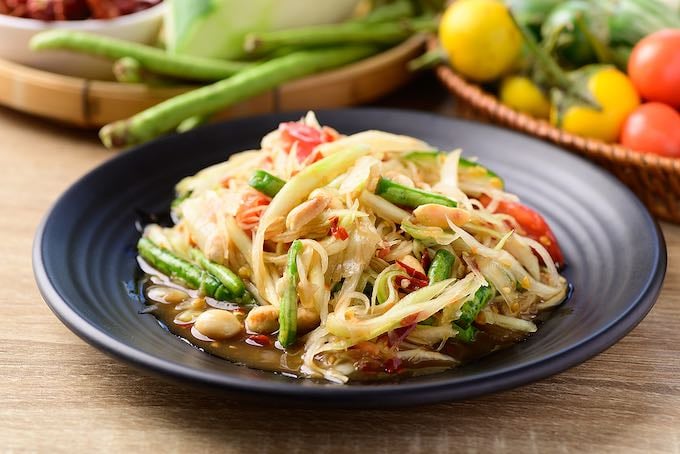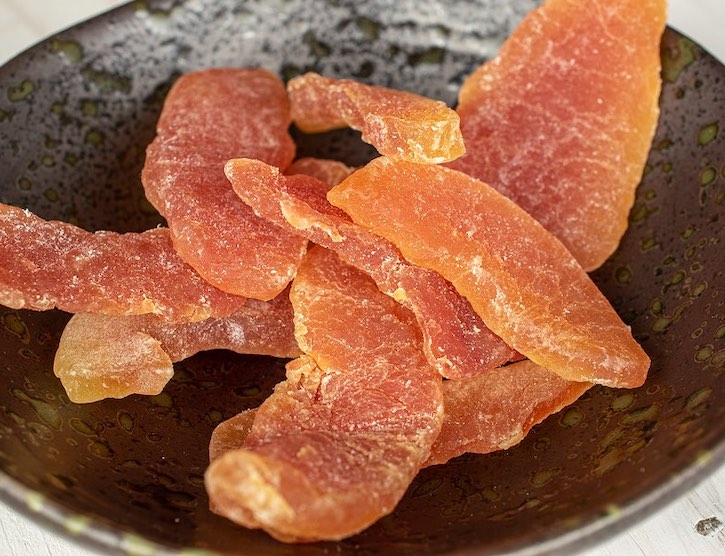Here’s a basic guide to papaya, a sweet tropical fruit with plenty of flavor and eye appeal. You’ll find information on varieties, prep tips, serving suggestions, and links to easy recipes.

Papaya’s juicy-sweet flesh has subtle flavor and slightly musky aroma. Low in acidity, it’s often served with a squeeze of lime or lemon juice, perhaps augmented with salt or pepper. Taste and color vary according to variety. Under the thin skin, soft flesh can be salmon-pink, canary yellow, or bright orange.
With the exception of green papayas (not unripe papayas but a specific variety), a hollow pocket holds multiple shiny black seeds. The contrast between flesh and seeds is visually stunning. The seeds are edible, with an appealing peppery flavor, but most often they are discarded.
This information is excerpted and adapted from Melissa’s Great Book of Produce: Everything You Need to Know About Fresh Fruits and Vegetables by Cathy Thomas ©2006, reprinted by permission of Melissa’s Produce.
Melissa’s Produce is a great resource for finding varieties of papaya, as well as almost any kind of produce under the sun.

Background
Having originated in Central America, papaya is considered a tropical fruit, growing best in an area with a tropical climate and plenty of rainfall.
In the areas where they originated, indigenous peoples used papayas as food as well as for medicinal purposes. Spanish and Portuguese colonizers of the 16th and 17th centuries carried the seeds to other areas, including India and the Philippines. Today, those two countries as well as Ceylon, Australia, and Hawaii all produce papaya. And the fruit is still cultivated in Central as well as South America.
Buying and storing
Except for the green papaya, which remains firm, look for fruit that gives very slightly to pressure, less than a ripe avocado, for instance. To ripen all but green papaya, use brown bag approach:
Place the fruit in a brown paper bag; loosely close the top of the bag and store at room temperature away from direct light (a cupboard is ideal). The paper bag traps ethylene while allowing exchange of air into and out of the bag. Check fruit daily; once it gives to gentle pressure. Refrigerate unwrapped when ripe, 3 to 5 days.
When fresh papaya isn’t available to you, try dried papaya. Chewy and sweet, it makes a good addition to fresh fruit salads or combined with other dried fruits and nuts in trail mixes, or just eaten as a snack. A little goes a long way, as those sugars get concentrated!

Papaya varieties and seasonality
GREEN PAPAYA
Domestic: none
Global: year-round
MARADOL PAPAYA
Domestic: none
Global: year-round
STRAWBERRY AND YELLOW-FLESH PAPAYA
Domestic: year round
Global: year-round
Nutrition info
Papaya is an excellent source of vitamins A and C and a significant source of potassium and fiber. It’s a rich source of antioxidants as well. See more detail about papaya’s benefits and a complete look at its nutrition profile.

Basic prep
Cut in half lengthwise. Scoop out seeds (if desired, use seeds as a peppery garnish or in salad dressing). If desired, peel papaya with vegetable peeler or paring knife. Cut into strips or dice, as needed. Or leave halves unpeeled and serve with spoon to scoop out flesh, or use as container for ice cream or salad. Green papayas (variety, not unripe fruit) are generally peeled and shredded.
 Som Tum is a classic Thai salad featuring green papaya
Som Tum is a classic Thai salad featuring green papaya
How to use papaya, with links to recipes
With the exception of green papaya, fruit can be used in sweet or savory dishes, raw or cooked. It is delicious in ice cream, sorbet, fruit salad, smoothies, and salsa.Green papaya is generally shredded and tossed with tangy dressing.
Breakfast papaya: Cut papayas in half lengthwise and scoop out seeds. Fill cavities with your favorite hot cereal and plant-based milk. Sprinkle with cinnamon
Papaya mint salad dressing: This tangy dressing can be used with green salads or fruit salad. If using papaya in a fruit salad, add it last and reserve some seeds, if desired, for a peppery taste; rinse seeds, drain, and use as garnish. Combine 1/2 medium ripe papaya, yellow or strawberry (peeled, seeded, and chopped), 1/2 cup papaya nectar, 2 tablespoons rice vinegar, 1/4 cup olive oil, and several mint leaves (to taste) in a blender. Process until smooth, then transfer to a bottle or spouted container. Refrigerate unused portion in a covered container and use within 2 days.
Roasted papaya: Martha Stewart presents Roasted Papaya with Brown Sugar, describes it: “Roasting halved papayas with brown sugar and ginger deepens the fruit’s natural sugars; a dash of cayenne and a squeeze of lime further enliven the dish.”

Southeast Asian green papaya salad: A Southeast Asian specialty, especially beloved in Thai cuisine. Note — if ordering in a Thai restaurant make sure it has no fish sauce. The good news is that you can always make it at home: Shred peeled green papaya. For dressing, combine 4 to 5 tablespoons fresh lime juice, 3 tablespoons natural granulated sugar, and 1/2 minced serrano chile. Toss and top with minced cilantro and chopped peanuts. Here’s another easy version of vegan Green Papaya Salad.
Papaya smoothie: Add a few chunks of seeded papaya flesh to your favorite smoothies. Combine with berries, bananas, and even greens for your green smoothies. Try this Double Thick Creamy Papaya Smoothie.
Papaya ice cream: Fresh papaya as an ice cream ingredient works very well. Here’s Four Ingredient Vegan Papaya Ice Cream and Papaya and Banana Ice Cream Bowls.
Papaya in fruit salad: Last but not least, one of the easiest ways to use papaya is to include it in colorful, seasonal fruit salads. Here’s a beautiful Tropical Fruit Salad and Mango Papaya Fruit Salad.

Dried papaya is fantastic, too!
You may also enjoy …

12 Unusual and Exotic Fruits You Need to Try at Least Once
See more Good Food Guides on this site.

Melissa’s Great Book of Produce is available wherever books are sold

Leave a Reply